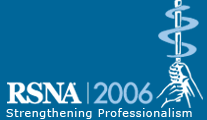
Abstract Archives of the RSNA, 2006
LL-NM2073-B08
Clinical Relevance of Discordant FDG-PET Findings of Bone Metastases with Bone Scan or CT
Scientific Posters
Presented on November 26, 2006
Presented as part of LLNM-B: Nuclear Medicine
Sung M. Kim MD, Presenter: Nothing to Disclose
Charles Michael Intenzo MD, Abstract Co-Author: Nothing to Disclose
Discordant FDG-PET findings of bone metastases with other imaging studies such as bone scan or CT have frequently been noted in clinical PET examination. To investigate natures of discordant or concordant scan finding between PET and other diagnostic imaging studies for bone metastases and its clinical relevance.
A retrospective reviews of 75 patients whose PET scan finding, suspicious of bony pathology and possible bone metastasis were carried out for follow-up clinical outcome. If the PET scan is positive, the scan findings were correlated with other imaging studies including bone scan, CT, MRI, with respect to a type of primary tumor, nature of osteolytic, sclerotic, or mixed, and concordancy or discordancy with other imaging studies.
Thirty-two patients had bone metastases. In 13 of these, PET finding showed more overwhelming metastatic lesions than that of other imaging studies; the types of primary tumor are breast (n=4), lung(n=4), lymphoma(n=2) and thyroid (n=1). In 12 patients, PET and other imaging studies showed concordant appearance; breast (n=4), lung (=3), lymphoma (n=2), colon and esophageal tumor one each. In 6 patients, bone scan and CT showed more lesions than PET scan; colon (n=3) and lung (n=3. PET scan is more positive in the osteolytic tumor; more frequent in lung cancer, colon cancer.
PET scan detects more bony metastases in the osteolytic tumor than that of bone scan.
FDG PET detects more bone metastases in the osteolytic tumor which could be a false negative in the bone scan.
Kim, S,
Intenzo, C,
Clinical Relevance of Discordant FDG-PET Findings of Bone Metastases with Bone Scan or CT. Radiological Society of North America 2006 Scientific Assembly and Annual Meeting, November 26 - December 1, 2006 ,Chicago IL.
http://archive.rsna.org/2006/4433081.html

